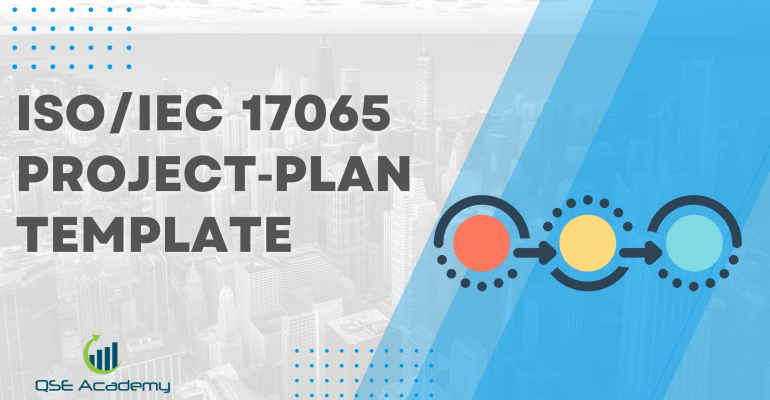ISO/IEC 17065 Project‑Plan Template
How a Clear ISO/IEC 17065 Project Plan Sets You Up for Accreditation Success
Every product certification body I’ve worked with starts with good intentions — but without a clear roadmap, they end up juggling tasks, chasing deadlines, and re-doing work that could’ve been right the first time.
That’s where an ISO/IEC 17065 Project-Plan Template changes everything.
At QSE Academy, we’ve helped dozens of certification bodies move from chaos to control. Our clients range from start-ups applying for their first accreditation to established CBs expanding into new product categories. The difference between smooth projects and stressful ones usually comes down to one thing: planning.
In this guide, I’ll walk you through how to structure your ISO/IEC 17065 project plan, customize it for your operations, and actually use it to stay on track — not just fill a binder. By the end, you’ll know exactly how to manage your accreditation journey step-by-step.
Understanding the ISO/IEC 17065 Project Plan: Foundation for Successful Implementation
A project plan isn’t just a timeline; it’s the backbone of your entire implementation. It defines what needs to happen, who’s responsible, and when it should be done.
Think of it as your GPS for achieving ISO/IEC 17065 accreditation.
Here’s what I’ve noticed — certification bodies often treat this as a documentation task. But in reality, it’s your control center for ensuring every clause from 4 to 8 is properly implemented.
Pro Tip: Align your project plan with the accreditation body’s application checklist from day one. It’ll make your submission smoother and save days of back-and-forth later.
Common Mistake: Treating the plan as “done” once it’s written. A good ISO/IEC 17065 plan evolves as you progress. Update it after each internal audit or management review — that’s how you keep it alive and useful.
 Step-by-Step Framework: How to Build Your ISO/IEC 17065 Implementation Roadmap
Step-by-Step Framework: How to Build Your ISO/IEC 17065 Implementation Roadmap
Creating your plan doesn’t have to feel overwhelming. Break it down into five practical stages:
1. Define the Scope
Clarify which product categories and certification schemes you’ll manage. This helps you align your resources and expertise early.
2. Assign Responsibilities
Every clause has an owner — your technical manager, scheme owner, or quality manager. Write it down. Accountability drives consistency.
3. Set Milestones
Typical ones include: gap analysis, document development, internal audit, management review, and accreditation application.
4. Establish Timelines
Give each milestone a realistic duration. For example, documentation might take six weeks; internal audit, two weeks.
5. Identify Required Resources
That means competent personnel, infrastructure, and documentation tools.
Here’s a quick example:
A mid-sized certification body once followed this five-stage plan and cut its accreditation prep time from 9 months to just 6.
Pro Tip: Include risk-management checkpoints throughout your plan. It not only supports Clause 4.1 (Impartiality) but also shows auditors you’ve built objectivity into your process.
Using QSE Academy’s ISO/IEC 17065 Project-Plan Template: Customize It to Your Context
When we designed the ISO/IEC 17065 Project-Plan Template, the goal was simple — give certification bodies a ready-made roadmap they could adapt in minutes.
Here’s how it’s structured:
- Overview section: project title, scope, accreditation body.
- Deliverables: mapped to each ISO/IEC 17065 clause.
- Task owner: assigns accountability.
- Due date: tracks milestones.
- Completion status: monitors progress visually.
Pro Tip: Link each activity directly to its clause number. It’ll make your next audit smoother, since evidence will be easy to trace.
Example: One of our clients, a European certification body, used this exact template. They customized the columns, added color-coded progress bars, and cut their accreditation prep time in half.
Common Mistake: Copying templates without adapting them. Every scheme has unique requirements — tailor your plan around your product scope, personnel, and infrastructure.
Monitoring Progress and Maintaining Momentum
Once your plan is active, tracking progress is what keeps everything on course.
A great plan doesn’t just say what should happen — it shows whether it’s happening.
Start with simple performance indicators like:
- % of documents approved
- % of personnel trained
- % of internal audit findings closed
Review these metrics in management meetings. It keeps your leadership engaged and your system aligned.
Pro Tip: Use a color-coded dashboard (green, yellow, red). It’s an easy way to communicate status at a glance.
Common Mistake: Waiting until the pre-assessment to measure progress. By then, it’s too late to fix major gaps. Track weekly or biweekly.
Aligning Your Project Plan with ISO/IEC 17065 Clauses and Accreditation Expectations
This part often gets overlooked — your plan isn’t just an internal document. It’s proof that you’ve implemented each clause methodically.
Here’s how alignment looks:
- Clause 5 – Structural Requirements: defines your organization’s framework and impartiality safeguards.
- Clause 6 – Resource Requirements: ensures competence, equipment, and facilities are ready.
- Clause 7 – Process Requirements: covers certification workflow — from application review to decision-making.
- Clause 8 – Management System Requirements: supports documentation control, internal audits, and continual improvement.
Pro Tip: Schedule internal reviews after completing each clause milestone. It demonstrates control and continual improvement — key points accreditation bodies look for.
Example: One client added a “Clause Review” column in their plan. It helped them present clear audit evidence that every requirement had been addressed before assessment day.
Post-Implementation: Reviewing and Updating the Project Plan
Once accreditation is achieved, don’t shelve your project plan. It’s now part of your continual-improvement toolkit.
After each surveillance or re-assessment, review what worked — and what didn’t. Document those lessons.
Pro Tip: Keep a “Lessons Learned” tab in your plan. Add short notes after every audit. Over time, it becomes a living knowledge base.
Common Mistake: Deleting or overwriting old versions. Keep them under document control — they’re evidence of your organization’s maturity and evolution.
FAQs
Q1: How detailed should my ISO/IEC 17065 project plan be?
Detailed enough to show control and accountability — but simple enough to manage daily. Include milestones, owners, and timelines without turning it into a 50-page report.
Q2: Can small certification bodies use the same plan?
Absolutely. The same framework works at any scale. Just merge roles or shorten timelines based on your team size.
Q3: Do accreditation bodies require a formal project plan?
Not explicitly, but they often ask how you managed implementation. Showing a documented plan demonstrates organization, foresight, and competence.
Conclusion: Turn Your ISO/IEC 17065 Plan into a Roadmap for Accreditation Success
Getting ISO/IEC 17065 accreditation isn’t about ticking boxes — it’s about managing a system that works in the real world. A strong project plan keeps your team focused, your progress measurable, and your audits stress-free.
At QSE Academy, we’ve seen how structured planning transforms certification bodies. When you know exactly what’s next, you move with purpose.
Your next step: Download the ISO/IEC 17065 Project-Plan Template and start turning your accreditation goals into clear, trackable milestones today.
Melissa Lavaro is a seasoned ISO consultant and an enthusiastic advocate for quality management standards. With a rich experience in conducting audits and providing consultancy services, Melissa specializes in helping organizations implement and adapt to ISO standards. Her passion for quality management is evident in her hands-on approach and deep understanding of the regulatory frameworks. Melissa’s expertise and energetic commitment make her a sought-after consultant, dedicated to elevating organizational compliance and performance through practical, insightful guidance.









